INDOOR INFRARED VS TRADITIONAL SAUNA:
A QUICK COMPARISON OF THE TWO
There are two main sauna types: infrared and traditional saunas. However, there's no such thing as the "best" sauna. It all boils down to what is the best sauna for you. The sauna you'll use the most is the best sauna, after all. In this guide, we'll explore indoor infrared vs traditional saunas, including their various health benefits, their differences, and how they work.


Infrared vs Traditional Saunas: How they work
For centuries, saunas have been used as steam baths for health, purification, relaxation, and to help treat or prevent various health issues.
According to research, sauna treatments can improve mood and pain, reduce the risk of developing Alzheimer's and heart disease, and even increase longevity. Recently, the infrared sauna, an alternative to the conventional Finnish-style sauna, has revolutionized how people use saunas.
Due to their rising popularity, many homeowners always ask, "Is an infrared sauna better than a traditional sauna?" As previously mentioned, neither is better than the other – they’re just different! Let's look at the differences below.
What is a Traditional Sauna?
A traditional sauna is a wooden structure with either an electric or wood-burning stove that heat a set of sauna rocks. By applying water to the heated rocks, a hot and humid space is created in which users can sweat out impurities, toxins, etc. A traditional sauna can provide numerous health benefits and can be large enough to accommodate several people, but can also be smaller in size for just one or two individuals. Traditional saunas work by heating the air to heat the body. The air is heated first, then the skin, and eventually, the core body temperature rises.

What is an Infrared Sauna?
While traditional saunas utilize dry heat or steam to warm a room, an infrared sauna uses advanced infrared heaters to heat the body directly. The infrared heat raises thermal energy, which then induces a deep and relaxing sweat in the body. This infrared heat penetrates the tissue and skin deeper than the traditional one. Infrared saunas have proven benefits of improving sleep, relieving joint stiffness and pain, reducing stress, improving hair and skin condition, improving circulation, and detoxifying the body.

Infrared vs Traditional Saunas: The Primary Differences
On the surface, the traditional steam sauna and infrared sauna look similar. Both types are made of wood, whether using infrared panels or traditional wood burning, or electric stoves to heat them. The wood is used for several reasons:
-
Wood was conventionally used in Finish saunas
-
Wood is a natural insulator and helps maintain the heat in the sauna
-
Wood is resistant to heat, and the right wood won't break or crack in the intense heat
-
Wood never gets too hot to touch, making it cozy to sit in
Although they have similar functions, there are several key differences that you need to know before purchasing one for your home. Understanding these differences will help you weigh the benefits and downsides and make the correct decision based on the right type. Let's look at the seven important differences.
Heating Method
The main difference between infrared and traditional saunas is the heat-generating method. Traditional saunas consist of a single heater that heats the air, which warms the user. It is made of a wood-lined room heated through an electric heater filled with rocks. You pour water on the heated rocks to create relaxing and healing sauna steam.
As your body warms up, a deep relaxing feeling sweeps over your muscles, joints, and ligaments, increasing blood flow. It's this aspect that gives a sauna its healing capabilities. The heat generated makes you sweat, which helps get rid of the body's toxins. Moreover, studies show that your hair and skin will improve significantly.
On the other hand, infrared saunas generate quality heat to heat your body directly. The sauna energy waves from the heater enter your body, warming you up. The infrared sauna requires around fifteen minutes of heating up before use. The infrared heat absorbs into the body, raising thermal energy and causing deep sweating.

The heat penetrates your muscles, ligaments, and nerves, causing blood to flow to these regions and allowing the important red blood cells to gather and repair your body. This process is similar in both sauna types. The only difference is that the traditional one transfers the heat to the body by heating the air, while the infrared type does so directly heating the body.
Temperature
Saunas using steam or "hot rock" need an ambient air temperature of around 70-80 degrees to stimulate sweat. However, infrared saunas can sustain an air temperature below 60 degrees while generating more purifying perspiration. Infrared saunas have a temperature of between 46-57 degrees, while they can get to 85 degrees a traditional one.
So, the air temperature in an infrared sauna isn't always the best indicator of how much heat the body takes in. The body is directly absorbing the energy waves and being directly warmed. Some sauna bathers may feel quite uncomfortable in the steamy environment of a traditional sauna. This makes an infrared sauna an ideal option for such people as it's easier to withstand. Some people, however, enjoy the hot steamy environment of a traditional sauna.

Heat-Up Time
It takes 30-45 minutes to heat up for a traditional sauna. The rocks are usually heated to the ideal temperature for soft and heated steam during this period. On the other hand, it takes between 10 to 15 minutes to heat an infrared sauna. Infrared saunas normally heat the body directly, meaning you can enter as soon as the heaters have attained the desired temperature.
Running Costs
The running costs of a sauna depend on the local costs per kilowatt-hour. You can find this on your power bill, the sauna's kilowatt rating, and how frequently you use the sauna. An infrared sauna is an energy-efficient option to traditional saunas because you don't have to wait as long before using it.
When using it three times a week, you can spend approximately $25 monthly on electricity for an infrared type. In contrast, a conventional sauna with a 6kW element might cost around $35 monthly when used thrice a week. Note that an idle sauna won't cost you anything. Prices will vary depending on where you live, so to get the most accurate running cost, you should count the costs per kilowatt-hour using the heater's rating.
Maintenance
A sauna is an investment to enjoy. Generally, saunas are low-maintenance, but like all things in life, will require regular cleaning and a bit of maintenance to keep them in tip-top shape. If low maintenance is a top priority, an infrared sauna is your best bet. Because infrared saunas only produce dry heat, the lack of steam and humidity helps prevent the growth of mildew and mold.
Conversely, traditional saunas are hot and humid spaces that can lead to mildew if not properly aired out. Therefore, you should clean your sauna regularly to keep it as hygienic as possible. Regardless of the sauna type, only use non-toxic and environmentally-friendly cleaning products. Never use harsh chemicals such as bleach. Additionally, sit on towels to avoid the build-up of sweat stains or germs on the benches and walls.
The Ultimate Sauna Experience
Another difference between the two types is how they feel. Traditional saunas are steamy and hot spaces ideal for short sauna sessions. Usually, bathers can only bear the heat up to 80 degrees for approximately 20 minutes. During the session, some individuals prefer taking cold showers, which is known as “the Nordic Cycle.”
In contrast, an infrared sauna produces lower heat that most people can enjoy in relative comfort. The heat remains at 50 to 60 degrees, devoid of humidity. Therefore, the ideal sauna experience depends on the heat type and the effect you want that heat to have on your body.
Infrared vs Traditional Saunas: Pros and Cons
Traditional Sauna Pros:
A real sauna experience: Conventional Finnish saunas are hot and steamy. This is an advantage for any individual who enjoys high temperatures and steam. You can also enjoy a dry heat experience by not pouring water over the rocks.
Humidity control: With a traditional sauna, you can control the humidity by removing or adding water. This allows you to set the humidity level as per your comfort level.
Outdoor use: Traditional saunas have the flexibility to be used indoors or outdoors.

Aromatherapy: You can also choose the luxury of aromatherapy which implies generating your own steam. You can do this by adding different essential oils to the water that you pour over the sauna rocks. Saunas provide an amazing setting to experience the glow of healing heat. They're also an ideal place of solace and community where you can relax with friends and family.
Traditional Sauna Cons:
Takes longer to heat: A traditional sauna takes approximately 30 to 45 minutes. In contrast, an infrared can take around ten to fifteen minutes to heat up.
Shorter sessions: Generally, traditional sauna sessions lasts around 10 to 15 minutes due to the heat. However, you can extend the experience by limiting the amount of steam by not pouring water on the rocks.
Infrared Sauna Pros:
No venting: An infrared sauna doesn't require a vent because of the lack of steam and dry heat.
Lower running costs: Infrared running costs are half as lower as traditional electric saunas.
Fast heat-up time: Unlike their traditional counterparts, infrared saunas only take 15-20 minutes to heat up.
Infrared Sauna Cons:
Limited outdoor use: Infrared saunas are not ideal for outdoor use. You can install them outdoors, but they should always be in a covered location, protected from the elements.
Lacks humidity: The lack of humidity could be a pro or a con depending on your preferences. For instance, if you prefer a steamy environment, then an infrared sauna is not for you. However, this will be a welcome change if you love your sessions dry.

SIGN UP. SAVE BIG.
Subscribe to be the first to know about our special monthly sauna sales, sent right to your inbox.
Infrared vs Traditional Saunas: Health Benefits
Both sauna types can provide stress reduction, relaxation, and detoxifying sweat. It's important to note that your kidneys remove toxins from the blood when your body is exposed to extreme heat. They can also help soothe aching joints and help you relax and loosen your muscles.
Besides, when the body takes in infrared heat, it generates thermal energy that causes a deep sweat at a lower temperature. This helps produce several health and anti-aging benefits. A traditional one does the same but in a hotter and steamy environment. Aside from lowering blood pressure and relieving pressure, both help individuals improve circulation, reduce wrinkles and fine lines, detoxify their bodies, and lose weight.
Here are additional health and physiological benefits that both sauna types provide:
-
Restorative stress escape
-
24/7 access to the decisive wellness retreat
-
Rewarding social oasis with family and friends
-
Powerful fitness friend and faster muscle recovery helper
-
Improved cardiovascular health
-
Effective pain management
-
Improved mental health
-
Powerful detoxification
-
Helpful for weight maintenance
-
Improved immunity
-
Better and more youthful skin
-
Improved and deeper sleep
-
Affordable and minimal maintenance
-
Management and prevention of numerous health ailments and conditions
Summary
The key difference between an indoor infrared and a traditional sauna is how the room is heated and the temperature. In most cases, the choice you go for depends on your personal preference.
If you're still unsure of the sauna type to install, we recommend you browse both our collections of traditional saunas and infrared saunas. And of course, feel free to reach out to our team with any questions!

About the Author
Adam Fromson
Adam Fromson, co-founder of My Sauna World, loves saunas and their transformative health benefits. With years of experience exploring sauna culture and its impact on health and wellness, Adam is passionate about helping others discover the life-changing benefits of saunas for themselves.
Let customers speak for us
from 385 reviews
Good communication, easy delivery, easy set up, easy operation, great value. Recommended!
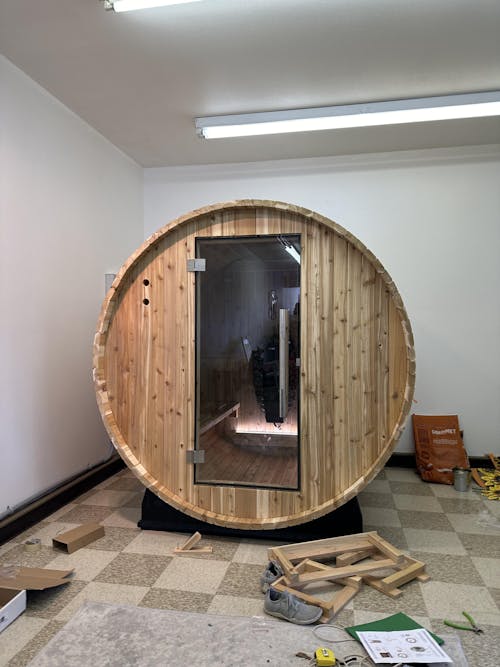
We ordered the 4 person barrel sauna and love it! We wanted a little extra space for the 2 of us/guests and it’s great. We could definitely fit 4 people in it if we needed. We use it every single day. It took about 10 weeks to get here because they build it specifically for the order. Putting the barrel together was fairly easy with 2 people. The electrical and the heater definitely required an electrician to install as we could have not done it alone.
We ordered the biggest heater (harvia spirit 8kw) and it heats up the sauna in about 15 mins inside our 40-50° garage. Overall this style of sauna is hotter and you sweat a lot faster than in an infrared sauna. I truly 10/10 recommend!
Pic is of us in the middle of building it.
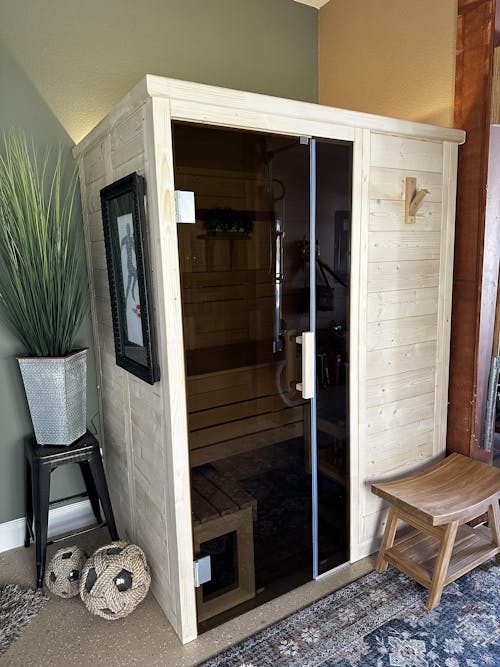
Took me about 6 hours over 2 evenings to assemble almost all by myself. Had a pro run a new circuit from my panel. Very well made and assembly was straightforward. Heater is well sized and reaches operating temperature in under 30 minutes.
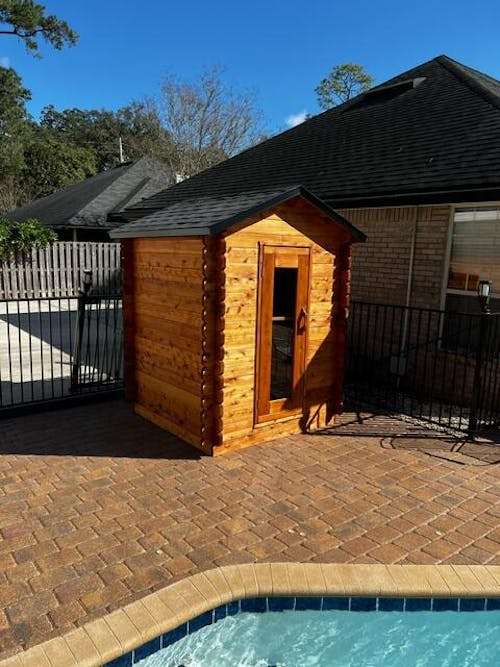
Great sauna very easy to assemble

The salt panel was a great addition to our Madison Sauna. It has excellent grain which is accented by the amazing color lights that glow through the panel. Also when you hit the rocks with a splash of water you can feel the heat bounce off the panel. Great addition if you are considering this option.
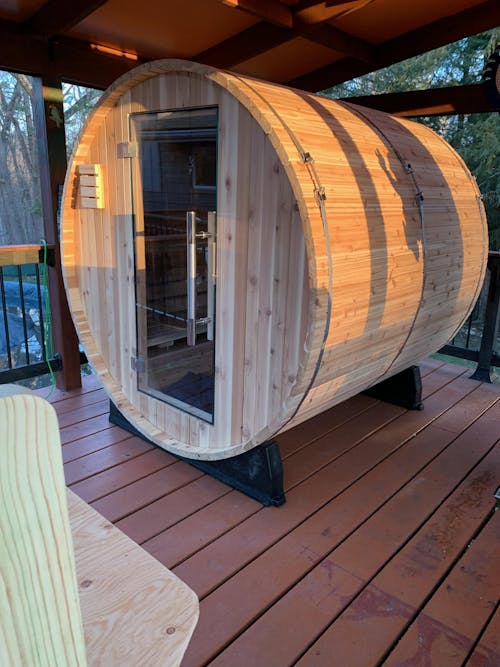
We can say enough about Sauna World there customer support is great! Our Pinnacle Sauna from Almost Heaven is epic.
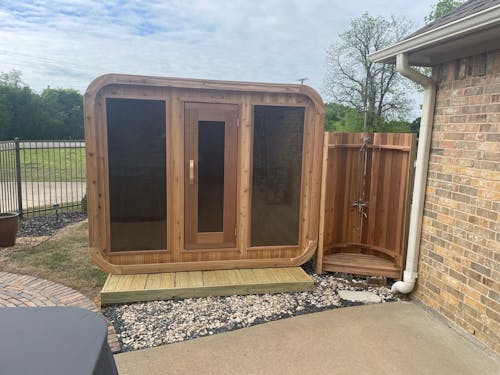
The finish and quality is outstanding and it was quick and easy to assemble.

We are thrilled with our mini pod!! It came well shipped and our friend assembled it in 11 hours! Wow! We cannot wait to get healthy and sauna it up!

Beautiful sauna!!! Much easier than I expected to assemble, took a total of 4 hours. Can't wait to get warm by the pool on those cool evenings. Customer service was excellent..

Purchased a 2 person Almost Heaven barrel sauna and were delighted with the product. The order process was quick and easy, the sauna arrived on-time, installation was simple, following the provided instructions, and the sauna is extremely high quality. We’ve used it daily for over 2 weeks and quite frankly I don’t know how we lived without it. If I had it to do over again I wouldn’t change a thing... except maybe purchasing a 4 person model to easier share with friends!

Great Customer Service and a breeze to put together.Excellent shipping and the Sauna is top notch, couldn’t be happier






























